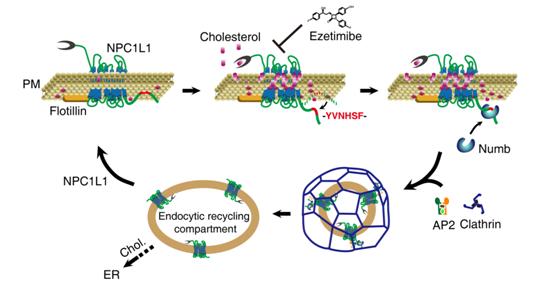
Hypercholesterolemia is a major risk factor for cardiovascular disease that is responsible for ~ 50% of all deaths in developed societies. Excessive cholesterol uptake is becoming a major cause of hypercholesterolemia. Although it had been shown that intestinal cholesterol absorption was mediated by vesicular endocytosis of the Niemann-Pick C1 Like 1 (NPC1L1) protein, the mechanism of sterol-stimulated NPC1L1 internalization was still mysterious. Recently, this was answered by Dr. SONG Baoliang and his research group from the Institute of Biochemistry and Cell Biology (SIBCB), Shanghai Institutes for Biological Sciences. They found that Numb protein, initially identified in Drosophila as a critical cell fate determinant, played an important role in NPC1L1 mediated cholesterol absorption.
Under the guidance of Dr. SONG, PhD student LI Peishan identified an endocytic signal in the cytoplasmic C-terminal tail of NPC1L1. Cholesterol binding on the N-terminal domain of NPC1L1 released the endocytic motif from association with plasma membrane and enabled Numb binding. Numb, a clathrin adaptor, specifically recognized this motif and recruited clathrin for internalization. Those results explain how cholesterol induces NPC1L1 endocytosis.
Next, they found that disrupting the NPC1L1-Numb interaction decreased cholesterol uptake. Ablation of Numb in mouse intestine significantly reduced dietary cholesterol absorption and plasma cholesterol level, and resistant to diet-induced hypercholesterolemia. Together, the researches identified Numb was a pivotal protein for intestinal cholesterol absorption and provided a therapeutic target for hypercholesterolemia.
The study entitled “The clathrin adaptor Numb regulates intestinal cholesterol absorption through dynamic interaction with NPC1L1” has been published online in Nature Medicine. This work was supported by the grants from the Ministry of Science and Technology of China, National Natural Science Foundation of China, Science and Technology Commission of Shanghai Municipality, and Xinjiang Science and Technology Department.

A working model showing the mechanism of NPC1L1-mediated cholesterol uptake. PM, plasma membrane. ER, endoplasmic reticulum. (Image by Dr. SONG Baoliang's group)

86-10-68597521 (day)
86-10-68597289 (night)

86-10-68511095 (day)
86-10-68512458 (night)

cas_en@cas.cn

52 Sanlihe Rd., Xicheng District,
Beijing, China (100864)

